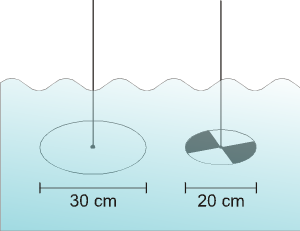Secchi depth
A Secchi disk is a round disc attached to a pole or a wire. This very simple instrument is used to measure the penetration of light in water. The disc is lowered in the water and the depth is recorded at which the disc is no longer visible with the human eye. The light penetration depth (the so called "Secchi Depth", SD) is recorded (in dm) from the graduation on the pole or wire at the moment the disc is not visible anymore.
The Secchi depth is reached when reflection of light from the water surface equals the reflection of light from the Secchi disc under water.
Although visibility (recorded as and by the Secchi depth) and attenuation (or extinction) of light are closely related, a truly linear relation is not found. The relation depends on the optically active substances in the water. In lakes which are rich in dissolved organics the light may reach the sediment but at the same time this light may not be suitable to support photosynthesis or growth of macrophytes.
Nevertheless various attempts to report a relation between SD and light attenuation are reported. In 1929 Pool and Atkins reported the relation using a location specific constant: K * SD = constant (the so called Pool-Aktins coefficient). Values reported for this PA coefficient vary in the range from 1,2 to 3. At a value of 1.7 the Secchi depth corresponds to 18% available light (compared to above water light). The explained variance when using the Pool-Atkins coefficient is mostly limited to 50-60%.
There are various reasons that explain why Secchi depth and light attenuation often do not well correlate: a light meter (such as e.g. a Lycor) ‘look’ upward, whereas visibility (SD) is the result of attenuation of light travelling downwards in the water and also light travelling, as a beam in a certain direction, upward to the eye of the observer. Light in an SD measurement thus travels in two directions (up and down). Also the spectral sensitivity is not the same.
SD = T/(c + K)
with:
- SD = Secchi depth (m)
- T = constant, 7 - 9
- c = beam attenuation for light in the visible or PAR range(400-700nm)(m-1)
- K = attenuation coefficient PAR (m-1)

Two types of Secchi discs.
"Secchi disks". Licensed under Public domain of Wikimedia Commons
